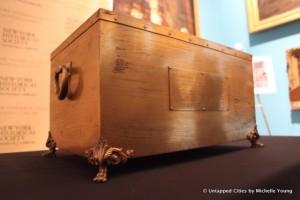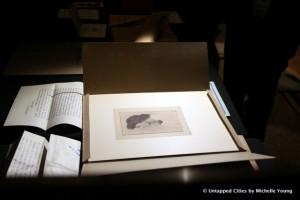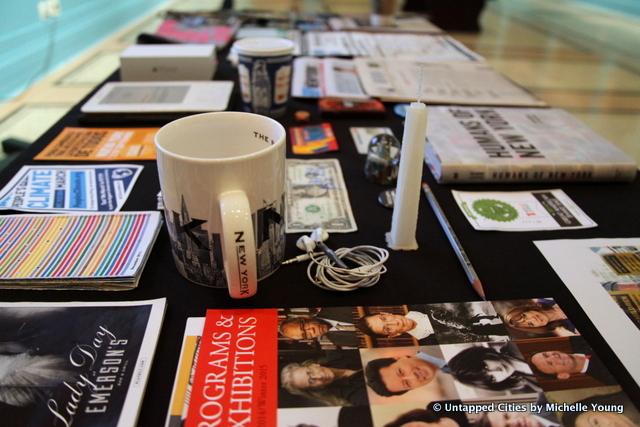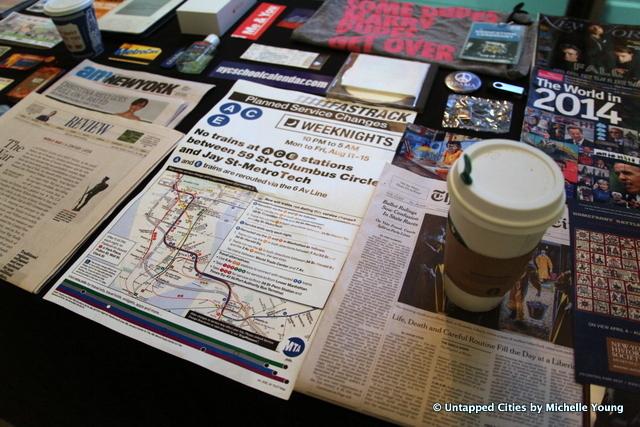 There is something fascinating about time capsules. They are messages from the past that were intentionally created to communicate something about the world as it was lived by those who selected the contents, with those in the future. It’s different than reading historical accounts or even antique objects themselves in that they were collected specifically to communicate with an as yet unborn future generation. It is the closest we can come as humans to speaking across the ages.
There is something fascinating about time capsules. They are messages from the past that were intentionally created to communicate something about the world as it was lived by those who selected the contents, with those in the future. It’s different than reading historical accounts or even antique objects themselves in that they were collected specifically to communicate with an as yet unborn future generation. It is the closest we can come as humans to speaking across the ages.
One of the oddest sensations when putting together a time capsule is the realization that there will be a moment in which everything you know, everything you are, and all that seems new to you will one day be someone else’s past. In 1914, a time capsule was created by the Lower Wall Street Business Men’s Association to be opened by someone living in the far off year of 1974. Unfortunately, as we all know, the best laid plans of mice and men often go astray and the capsule was misplaced. When it was rediscovered in the 90s the decision was made to delay its opening until 2014, one hundred years after it was originally created.
 When it was opened, with all of the pomp merited by such an occasion, it gave forth a number of fascinating documents and images that gave a picture of the world’s important events as seen by its creators. It also, not surprisingly, caused a renewed fever of interest in time capsules and the New York Historical Society extended an invitation to a group of high school students in New York City to assemble the documents and objects that should be contained to ‘pay it forward’ so to speak to the next generation of time-capsule explorers.
When it was opened, with all of the pomp merited by such an occasion, it gave forth a number of fascinating documents and images that gave a picture of the world’s important events as seen by its creators. It also, not surprisingly, caused a renewed fever of interest in time capsules and the New York Historical Society extended an invitation to a group of high school students in New York City to assemble the documents and objects that should be contained to ‘pay it forward’ so to speak to the next generation of time-capsule explorers.
In an effort to capture the zeitgeist of 2014, the students included things such as books and newspapers, New York souvenirs, an Obama button, a metro card, a small bottle of hand sanitizer, a t-shirt reading “some dudes marry dudes, get over it” and, of course, a Starbucks to-go cup. Looking among the items meant to tell the future citizens about the New York of 2014, it is possible to see a small World Trade Center souvenir that, upon closer inspection, appears to have been 3D printed. It sits on a small print raft and stands only slightly taller than the coffee mug next to it.
 This will be the picture of the state of 3D printing at this moment that is received by our descendants in 2064. It begs the question: what will future generations think of our cutting-edge advanced 3D printing technology? Will it someday hold the cache and nostalgia that is wrapped up in old photographs? Will it be the subject of ridicule or as obsolete as the cylinders for 19th century phonographs?
This will be the picture of the state of 3D printing at this moment that is received by our descendants in 2064. It begs the question: what will future generations think of our cutting-edge advanced 3D printing technology? Will it someday hold the cache and nostalgia that is wrapped up in old photographs? Will it be the subject of ridicule or as obsolete as the cylinders for 19th century phonographs?
It is interesting to think about how far we may have come down the line of development and to wonder how much farther the technologies future stretches out ahead of us. We were all promised when we were young that flying cars would be part of our future, how many of the hopes and aspirations for 3D printing will one day be seen as fanciful as the idea of a robot housekeeper and how many of them will have been realized?
All we can do now, is communicate to those who open the capsule in 2064 the importance we were beginning to give to this technology as this is quite possibly the first 3D printed object to be included in a time capsule. The fact that it made the cut indicates how much a part of daily life it is becoming, and the fact that it only just now did so indicates a watershed moment in its historical development.
 It is also the beginning of a long running experiment in which we ask how the 3D printed object will hold up over a period of 50 years. When we think about archeological evidence of past civilizations, it is often through objects such as pottery that we learn about the culture of a people. Will 3D printed objects hold up as well or will the PLA’s biodegradability mean that ultimately, it will vanish without a trace?
It is also the beginning of a long running experiment in which we ask how the 3D printed object will hold up over a period of 50 years. When we think about archeological evidence of past civilizations, it is often through objects such as pottery that we learn about the culture of a people. Will 3D printed objects hold up as well or will the PLA’s biodegradability mean that ultimately, it will vanish without a trace?
I may have to start eating better and exercising regularly so that I can make sure to find out how the trinket fairs when they open the capsule in 50 years. Let’s hear your thoughts on this story in the 3D Printing and Time Capsule forum thread on 3DPB.com
Subscribe to Our Email Newsletter
Stay up-to-date on all the latest news from the 3D printing industry and receive information and offers from third party vendors.
You May Also Like
3D Printing Unpeeled: New Arkema Material for HP, Saddle and Macro MEMS
A new Arkema material for MJF is said to reduce costs per part by up to 25% and have an 85% reusability ratio. HP 3D HR PA 12 S has been...
3D Printing News Briefs, January 20, 2024: FDM, LPBF, Underwater 3D Printer, Racing, & More
We’re starting off with a process certification in today’s 3D Printing News Briefs, and then moving on to research about solute trapping, laser powder bed fusion, and then moving on...
3D Printing Webinar and Event Roundup: December 3, 2023
We’ve got plenty of events and webinars coming up for you this week! Quickparts is having a Manufacturing Roadshow, America Makes is holding a Member Town Hall, Stratafest makes two...
Formnext 2023 Day Three: Slam Dunk
I’m high—high on trade show. I’ve met numerous new faces and reconnected with old friends, creating an absolutely wonderful atmosphere. The excitement is palpable over several emerging developments. The high...































